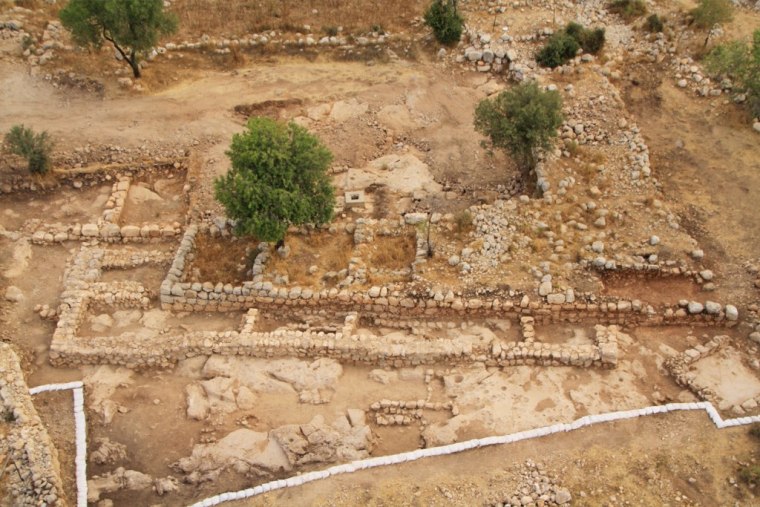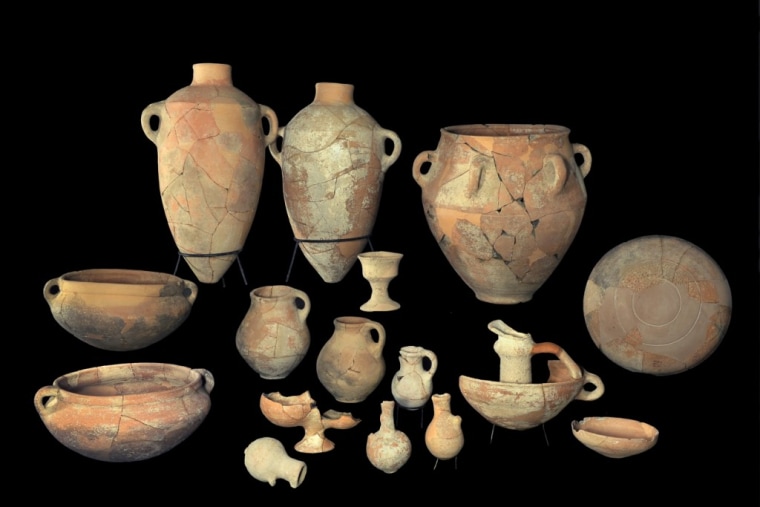
Israeli archaeologists say they have found the remains of a palace that they believe was a seat of power for the biblical King David — but other experts say that claim shouldn't be taken as the gospel truth.
The discovery, announced on Thursday by the Israeli Antiquities Authority, revives a debate over one of the Bible's central stories as well as the origins of the ancient Jewish state. The debate focuses on an archaeological site known as Khirbet Qeiyafa, about 20 miles (30 kilometers) southwest of Jerusalem. Khirbet Qeiyafa has been associated with the ancient city of Sha'arayim, which is mentioned several times in Jewish scriptures as Judean territory.
For seven years, archaeologists from the Hebrew University of Jerusalem and the antiquities authority, or IAA, have been excavating the site — and finding ample evidence of a fortified city dating back to around 1000 B.C. That's the era when the House of David is thought to have ruled over the Israelite tribes.
On Thursday, the Hebrew University's Yosef Garfinkel and the IAA's Sa'ar Ganor announced the completion of the excavation. They said they uncovered evidence of a 10,000-square-foot (1,000-square-meter) palace in the center of Khirbet Qeiyafa, with a 100-foot-long (30-meter) protective wall. A pillared building to the north was apparently used as an administrative storeroom.
'Unequivocal evidence'
The two buildings serve as "unequivocal evidence of a kingdom's existence," Garfinkel and Ganor said in an IAA statement.

"Around the palace's perimeter were rooms in which various installations were found — evidence of a metal industry, special pottery vessels and fragments of alabaster vessels that were imported from Egypt," they said.
The Israeli newspaper Haaretz quoted Garfinkel as saying "there is no question that the ruler of the city sat here, and when King David came to visit the hills he slept here."
The storeroom could have been used for taxes collected from the surrounding residents in the form of agriculture produce. "Hundreds of large store jars were found at the site whose handles were stamped with an official seal, as was customary in the Kingdom of Judah for centuries," the archaeologists said.
They said that the fortified city was probably destroyed in a battle with the Philistines around 980 B.C., and that the ruins of the palace were covered over during the construction of a fortified farmhouse during the Byzantine period, about 1,400 years later.
Claims disputed
The view that Khirbet Qeiyafa was a power center for the Kingdom of Judah and the House of David has long been disputed by other archaeologists. On one level, some archaeologists argue that Khirbet Qeiyafa could have been a Canaanite settlement, or an outpost for the ancient northern Kingdom of Israel rather than the southern Kingdom of Judah.
On a deeper level, the skeptics say there's no firm evidence that the historical David was as powerful as the Bible makes him out to be. They suggest that the inspiration for the biblical figure might have been a miscellaneous tribal leader, or perhaps even a folkloric figure on a par with, say, Robin Hood.
The latest claim about King David's palace came in for harsh criticism from David Willner, co-director of Foundation Stone, who said Garfinkel was indulging in "unabashed sensationalism." On the Bible History Daily blog, Noah Wiener said the dramatic link to David was "sure to elicit a great deal of debate."
"Khirbet Qeiyafa is an undoubtedly important site, and we look forward to an imminent archaeological discussion on the newly uncovered palatial structure," Wiener wrote.
More about biblical archaeology:
- Inscription dates back to King David — but what's it say?
- Artifacts hint at history behind David and Goliath
- Gallery: Eight Jewish archaeological discoveries
- Israelis find 2,750-year-old temple
Alan Boyle is NBCNews.com's science editor. Connect with the Cosmic Log community by "liking" the NBC News Science Facebook page, following @b0yle on Twitter and adding the Cosmic Log page to your Google+ presence. To keep up with NBCNews.com's stories about science and space, sign up for the Tech & Science newsletter, delivered to your email in-box every weekday. You can also check out "The Case for Pluto," my book about the controversial dwarf planet and the search for new worlds.
